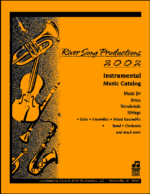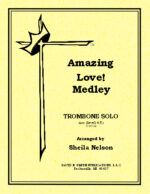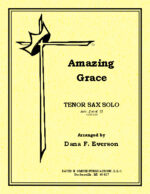-
-
Amazing Grace
$5.95Moving and affective this solo begins unaccompanied and then later joined by the piano in a Celtic style. A second statement of the tune is further embellished and gains more complexity as it progresses. After a brief modulation the solo line becomes more plaintive- even though still embellished. The Coda is based on a brief motif where it ritards into a gentle repose.
-
Amazing Grace
$5.95Moving and affective this solo begins unaccompanied and then later joined by the piano in a Celtic style. A second statement of the tune is further embellished and gains more complexity as it progresses. After a brief modulation the solo line becomes more plaintive- even though still embellished. The Coda is based on a brief motif where it ritards into a gentle repose.
-
Amazing Grace
$5.95Moving and affective this solo begins unaccompanied and then later joined by the piano in a Celtic style. A second statement of the tune is further embellished and gains more complexity as it progresses. After a brief modulation the solo line becomes more plaintive- even though still embellished. The Coda is based on a brief motif where it ritards into a gentle repose.Unusual, emotive and restrained version of the Luther classic The introduction in the piano is presented in an embellished fashion. The solo states the theme in a straight-forward manner. After a brief interlude the solo continues in a different register. Another brief interlude and the soloist continue in a more ornamented manner this time. The piano now states the theme in strong block chords while the solo is very active as an obbligato. Both voices present thematic materials taken from the opening sections. The Coda gives a motivic statement of the opening theme and resolves to a solemn end.
-
Amazing Grace
$5.95Moving and affective this solo begins unaccompanied and then later joined by the piano in a Celtic style. A second statement of the tune is further embellished and gains more complexity as it progresses. After a brief modulation the solo line becomes more plaintive- even though still embellished. The Coda is based on a brief motif where it ritards into a gentle repose.
-
Amazing Grace
$5.95Moving and affective this solo begins unaccompanied and then later joined by the piano in a Celtic style. A second statement of the tune is further embellished and gains more complexity as it progresses. After a brief modulation the solo line becomes more plaintive- even though still embellished. The Coda is based on a brief motif where it ritards into a gentle repose.
-
Amazing Grace
$5.95Moving and affective this solo begins unaccompanied and then later joined by the piano in a Celtic style. A second statement of the tune is further embellished and gains more complexity as it progresses. After a brief modulation the solo line becomes more plaintive- even though still embellished. The Coda is based on a brief motif where it ritards into a gentle repose.
-
Amazing Grace
$5.95Moving and affective this solo begins unaccompanied and then later joined by the piano in a Celtic style. A second statement of the tune is further embellished and gains more complexity as it progresses. After a brief modulation the solo line becomes more plaintive- even though still embellished. The Coda is based on a brief motif where it ritards into a gentle repose.
-
Amazing Grace
$5.95Moving and affective this solo begins unaccompanied and then later joined by the piano in a Celtic style. A second statement of the tune is further embellished and gains more complexity as it progresses. After a brief modulation the solo line becomes more plaintive- even though still embellished. The Coda is based on a brief motif where it ritards into a gentle repose.
-
-
-
Amazing Grace
$5.00This solo opens with a gentle, Celtic fashion in a duple meter. It progresses through a series expressive obbligati giving a sense of elevation. As it nears the end it modulates metrically and harmonically to a triple meter, and then final repose.
-
Amazing Grace
$30.00Beginning with a horn rubato soli, features a modal open solo section in the middle before returning to the rubato Gospel Blues which features the piano. … Sx, 3 Tbn, Pno, Bass, Gtr, Organ)
-
-
-
-
-
-
Amazing Grace
$20.00(in manuscript at this time)(Music to accompany congregational singing. Scored for full orchestra but are playable by smaller groups. May also be performed by instruments alone. Parts included for kybd and/or rhythm) 4 verses in F,F,G, & Ab
-
-
Amazing Grace
$4.00This flute solo is motivically driven much in a Celtic style. Expressive throughout, the piece culminates in a quiet repose.
-
Amazing, Amazing Grace
$12.00Scoring is for 2 trumpets, horn, trombone, and tuba with optional horn and baritone parts. The piece resembles a theme and variations form, giving many different flavors of this timeless hymn-Amazing Grace.
-
Amazing Love!/Medley
$8.00A trombone solo for the advanced player built of: “And Can It Be,” “My Saviour’s Love,” “Jesus Loves Even Me,” and “Such Love.” The piece is a combination of a medley and theme and variations and incorporates multiple tongues in sections. A piece of many styles and a pleasure for the listener and the player.
-
-
Amazing Grace
$5.00This solo opens with a gentle, Celtic fashion in a duple meter. It progresses through a series expressive obbligati giving a sense of elevation. As it nears the end it modulates metrically and harmonically to a triple meter, and then final repose.














